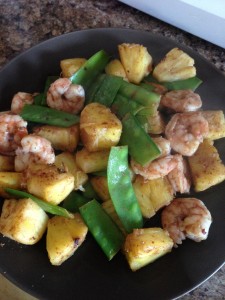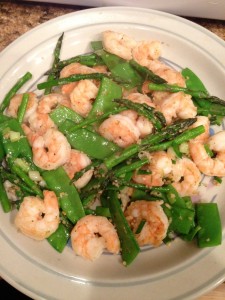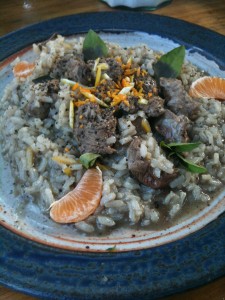Two modern shrimp recipes from Alice the Cook
SHRIMP WITH PINEAPPLE AND PEA PODS

2 cups raw shrimp, peeled and deveined
1 cup pineapple, 1″ cubed
1 cup Chinese pea pods, tips removed
1 tbsp sesame or olive oil
1 tsp of Chinese five spice or 1/2 tsp garam masala (spicier)
3 pinches of kosher salt
2 pinches black pepper
Optional: 1/2 cup red bell pepper
Heat up a sauté pan over medium heat. Add the oil. Once heated add the shrimp first and the fruit and vegetables immediately after. Stir occasionally.
Add spices (garam masala or Chinese five spice), salt and pepper
Continue to cook until vegetables are bright green and the shrimp is done (the shrimp should be
pink).
Serves 2
ITALIAN SHRIMP

2 cups of medium raw shrimp, peeled and deveined
1 cup of young asparagus
½ cup of green onions, diced
1 zucchini, shredded
2 cloves of garlic, minced finely
4 large basil leaves, chiffonade (rolled and then sliced)
½ cup of baby portabella mushrooms, minced
½ tsp of dried red pepper
salt and pepper to taste
1 tbsp olive oil
1 lemon, zested and juiced
Heat up the pan and add the olive oil. Add the shrimp with the garlic, basil, dried red peppers and lemon zest and sauté for 1 minute. Add all of the vegetables and stir lightly.
Continue to cook until vegetables are el dente and the shrimp is thoroughly cooked. Can be served with risotto or some nice crusty bread.
Serves 4
Birth of Risotto
Rice was introduced to the Italians and Spaniards by the Arabs during the Middle Ages. The weather along the Mediterranean Sea was ideal for growing the shorter grained rice, like the Arborio, and the merchants in Genoa, Venice and surrounding towns were able to profit from the rice growing industry that catered to the wealthy.

As interest in trade with the Mediterranean increased, others discovered the Italian delicacy and the demand increased for the short-grained rice. The Italian merchants’ profits grew as only the wealthy could afford the rice and other merchants took interest in this profitable product and began providing it as well. The increased availability flooded the market and lowered the price of the rice, making it more affordable.
Southern Italians had used the rice as a staple and slow-cooking (cooking over a low heat source for a long period of time) was predominantly used to prepare the daily meals. When slow-cooking the meals with the short-grained rice, it would combine the rice’s naturally occurring starch with rich stock or broth and create a creamy sauce; this practice would create risotto.
The recipe below utilizes the same principles of items found in southern Italy – lamb, citrus (lemons and oranges), olive oil, Arborio rice, and lemon basil. Although lamb is not commonly combined with citrus, but in this case it complements the risotto. Thus, creating a rich meal that tastes like it would be made for a special occasion, but is relatively easy to make.
Citrus Lamb with Risotto
Ingredients
2 lbs of lamb cubed
1 whole lemon (juice and zest)
1 tsp of orange zest
2 cups of lamb stock (veal or beef stock can be used instead)
1 cup Arborio rice (uncooked)
1 tsp of lemon basil, minced
1 tbsp olive oil
Sea salt (to taste)
Black pepper (to taste)
Remove the zest (skin) from the entire lemon and cut the lemon in half. You may use a zester (like a smaller cheese grater) or hand-shave the zest with a sharp knife; make sure you do not include the white pith (the area between the zest and the fruit). Once shaved, mince the zest and hold aside; the zest will provide most of the citrus flavor in this dish. You may do the same thing with an orange to get fresh orange zest.
Use a fork to pierce the lemon and squeeze the juice into a cup. The piercing will help remove the juice more efficiently. Make sure there are no seeds in the juice and set aside for later. Dispose of the lemon once the zest and juice have been harvested.
Add medium heat to a large skillet or pot and add the olive oil; add the lamb and a teaspoon of the lemon zest to brown slightly. Remove from the lamb from the pot and put aside, but leave the remaining fat and oil in the pan.
Place the pot back onto the medium heat and add the rice; brown the rice in the lamb fat and olive oil. Once browned, begin slowly adding the stock on medium heat while constantly stirring. Add the juice from the lemon to the rice. Add a lid to the sauce pan and continue to cook until both the rice has puffed up and a most of the stock has evaporated.
Add the lamb and the remaining lemon and a half teaspoon of the orange zest and lemon basil. The remaining orange zest and lemon basil will be used as a garnish prior to serving. Continue to cook the lamb and add salt and pepper to taste.
Serve family style on a single plate or bowl and sprinkle the remaining orange zest and lemon basil on top of the dish as a garnish. For the photo, small orange slices were added for additional color.
Spice Blends from our Demonstrations
Each day, we demonstrate how to make various spice blends over an open fire. An earlier entry – http://alicethecook.com/?p=801 talks about how we do it, but doesn’t necessarily cover the recipes. Due to popular demand, below are the spices we demonstrate (and sell) at the Minnesota Renaissance Festival.
Spices change based on the tastes of individuals and family units. Some prefer savory tastes and others prefer a spicier blend. You can adjust accordingly.

Please remember that you need to use a hot, dry cast iron plate for toasting these spices.
- Gather your spices
- Toast the spices
- Grind up the spice. You can use an electronic grinder, but make sure you do not use a coffee grinder. Keep them separate so that you can enjoy both.
- Use the spices as needed
As the spices age after grinding, they diminish potency significantly over time. Most of the ingredients can be purchased through a co-op or a spice specialty store, such as Penzey’s Spices or Spice House; I’ve also had a lot of luck locating hard-to-find spices through Amazon.com.
If you to make more spices make sure you freeze your spices in an airtight bag to minimize the loss of flavor.
- Garam Masala: cumin, coriander, black pepper, cardamom, chilies, clove, cinnamon, and nutmeg
In the case of garam masala, you would toast the spices together and grind them. - Curry: sea salt, mustard seeds, turmeric, garam masala, coriander, garlic, ginger, and cumin
In the case of the curry, you would begin toasting the mustard seeds until they begin to pop. You would then add the salt, coriander, garlic, ginger, and cumin. As a note, I would strongly recommend using dried spices instead of fresh ginger and garlic as they will scorch on a hot pan. Once toasted, I would begin grinding and then add the garam masala and the turmeric after. - Ras El Hanout: cinnamon, cloves, corriader, cumin seeds, allspice, nutmeg, cardamom (use sparingly), ginger, fennugreek, fennel seeds, mustard seeds, dried Damascus rose petals, and optional chilis
Like the garam masala, these would be toasted and ground together. The rose petals will float to the top and be the last ingredient to grind.
I hope you enjoy these as much as we do!
Red Cabbage (Oktoberfest)
Ingredients:

2 1/2 oz. bacon, either American or German “Bauchspeck”, chopped
1/2 c. onion, diced
4 c. shredded red cabbage, about 1 lb.
1/2 c. dry, red wine
1/2 c. apple juice
1 T. honey
1 bay leaf
4 cloves
Ground black pepper
1 apple, peeled and quartered
Preparation:
Brown bacon in a dutch oven (to make a vegetarian option, use tbsp of olive oil instaed of bacon). Add onions and sauté for 5 minutes. Add the cabbage and cook for 2-3 minutes. Pour in red wine and juice to deglaze, add the spices, sugar and apple.
Simmer on stove top for 2-3 hours, stirring occasionally. Keep the liquids one finger width (1/2 inch) deep, adding apple juice or water. Adjust seasonings. Serve hot.
